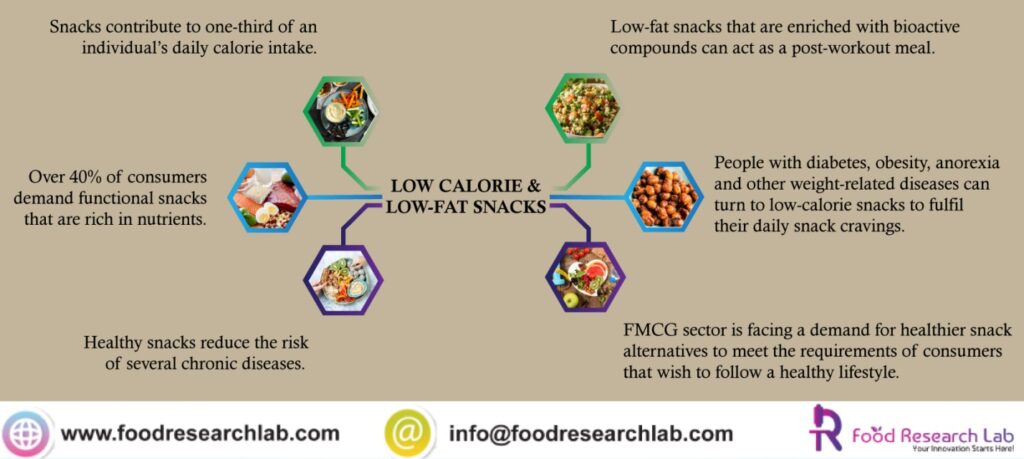Mushrooms are rich in high quality proteins, vitamins, minerals, fibers and phenolic compounds are considered to be healthy ingredient in a lot of cuisines. Enoki (Flammulina velutipes) mushrooms are also popularly known as velvet stem, golden needle, and winter mushrooms are very much recognized for their distinct flavour and nutritional profile. Enoki mushrooms have a pure white bean sprout on a velvety stem. Moreover, cultivated varieties have a little white cap and the wild variety have a larger brown shiny cap. Generally, the stems are removed during mushroom harvest and are used for composting.
Formulating New Product with Bioactive Properties
Indulging snacks and healthy foods seems counterintuitive, however, 40 % of consumers are demanding functional snacks with enriched levels of antioxidants, fibers and vitamins are increasing. One of the commonly consumed types of snacks is the baked variety which contains low-fat and preferable high fiber. Research is currently being focused on enhancing the nutritional value with the addition of fiber and protein flours into baked and extruded snacks.
Grains with phenolic phytochemicals, such as cinnamic acids, benzoic acids, flavonoids, flavones, anthocyanidins, lignans and alkyl-resorcinols are chosen for such snacks. For instance, oats are considered for their cholesterol-lowering effects due to their soluble fibre, β-glucan. The phenolic and antioxidants content have been highlighted.

The advantage of β-glucans is that they are associated with increased viscous properties which have high molecular weight. Moreover, β-glucans are easily digestible by their enzymes β-glucanases. Scientists or food technologists have to take extra steps to prepare the β-glucan fiber to inactivate the endogenous enzyme present in the grain. These modifications are much required to keep the processes short and reactive. During the development of low-calorie snacks, the incorporation of β-glucans in sufficient amounts replaces the large amounts of flour to lower the bad impact of wheat flour and gluten proteins. The incorporation of xylanase to the barley dough improved the overall volume, appearance and final crumb structure. This addition also increased the health benefits of the amount of soluble fiber content in the snacks or bread.
Some researchers suggest that the nutritional and bioactive properties of tortilla chips are based on the maize variety. Elotes conicos have been found to have the highest antioxidant activity. Tortilla chips are made by the nixtamalisation process which involves a lot of stages, such as washing, alkaline cooking, and stone-ground to make masa. Corn masa is made into a dough which is then baked or fried to form our favourite tasty and energetic tortilla chips. Tortilla chips are high in lipophilic antioxidant activity, B-vitamins, calcium, proteins and high oxygen radical absorption activity due to the nixtamalisation procedure. Mexican pigmented maize landrace has a higher content of carotenoids and lipophilic activity. The impact of nixtamalization with Ca salts on blue maize tortillas was studied and was found to contain enhanced antioxidant capacity, and carbohydrate digestibility.
The addition of broccoli trimmings into tortilla was studied based on the final physicochemical, sensory and nutritional compositional. Broccoli flour was added to the tortilla dough at different ratios of 2% to 8%. It was observed that the overall protein concentration increased by 1.5%, crude fibre by 1.2%, lysine by 9.56 g/kg protein and the calcium content by 0.30 g/kg in the fortified tortilla chips. Moreover, the overall oil uptake content was found to be much lower by as much as 10.5% in comparison to the deep fried fries. Consumer acceptance was increased and 76 % of consumers preferred tortilla chips with 4% broccoli flour with enhanced taste, texture and price factors. The addition of broccoli flour to 8% increased protein by 17.3%, fiber by 63.2%, lysine by 49.1%and calcium by 62.2%.
Huitlacoche is a commonly consumed mushroom in Mexico, which forms corn smut, tumours in ears, stems, tassels and leaves. Plant Huitlacoche is a high source of proteins with high content of dietary fiber and essential fatty acids such as linoleic and linolenic acids. Huitlacoche is proven as a functional food that produces bioactive compounds to be used as functional foods. These are also consumed with nixtamalized corn which is edible and no processing. Many researchers have found that the nixtamalization process reduces the total polyphenols, antioxidants and anthocyanin contents. Moreover, thermal alkaline processes decrease the overall anthocyanin and phenolics content. Once the tortilla dough is kneaded and cooked, the antioxidant capacity was found to increase due to the soluble phenolics. Tortilla made with coloured flour was found to have significant 3 times enhanced activities of higher antioxidants, 40% improvement in polyphenolics and improved expansion samples. The colour and final antioxidant activity of tortilla chips have been directly correlated to the anthocyanin and phenolic contents.
To conclude, the huitlacoche is a remarkable source of fiber, antioxidants and phenolic compounds, which can be used in the formulation of baked snacks. This results in increased phenolic and antioxidant properties of tortilla chips when compared to its commercial competitors. In contrast, the applied heat treatment in this process leads to the loss of part of their total bioactive properties. The functional, structural and physicochemical properties of tortilla chips have changed significantly due to the addition of huitlacoche. The functional properties of huitlacoche phytochemical contents are the sole reason for the bioactive properties of the resultant tortilla chips. The fortified tortilla chips were also found to have many health benefits.
Food Research Lab can help you solve these problems with related to formulation of low calorie snacks using bioactive compounds. FRL is for food and nutraceutical manufacturers as well as those companies involved in NPD and developing spec without manufacturing. FRL gives you the ability to improve all phases and aspects of new product development, such as original specification, ideation, shelf-life, packaging. Additionally, you can get them out to market quicker than ever before.

Let’s create something Innovative and Delicious together
Food Research Lab strives for excellence in new Food, Beverage and Nutraceutical Product Research and Development by offering cutting edge scientific analysis and expertise.




